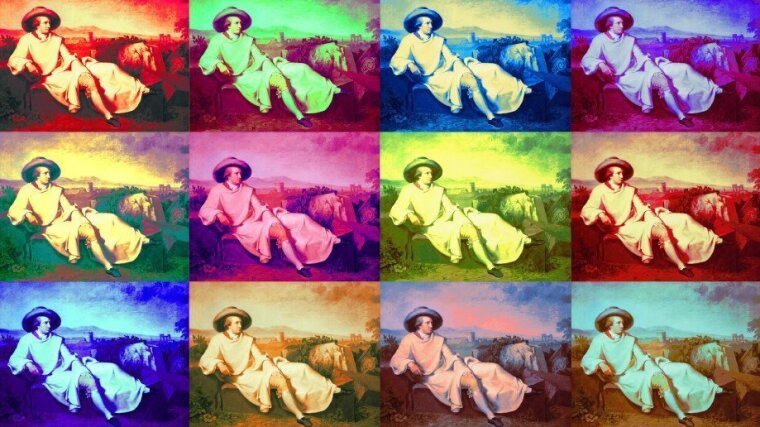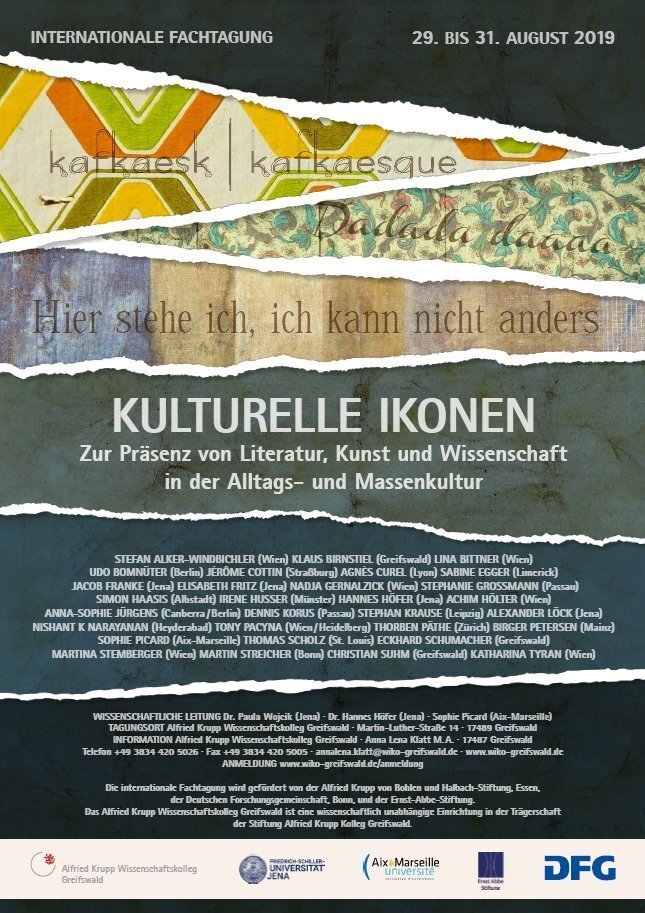
Cultural Icons. On the Presence of Literature, Art and Science in Everyday and Mass Culture
Literature, art, and sciences are in vogue in mass culture: Quotations or samples from literature, scientific works, music or paintings can be found in public spaces: on house walls, on posters, in hip cafés, bars and shops, on T-shirts, or as tattoos, in pop music or as memes in social media. They have also arrived in the thing culture: images of the double helix or Einstein on potholders, a doll of Alan Ginsberg, Goethe as a salt shaker, Shakespeare as a rubber duck. And they are alive in the entertainment culture through mass media (documentations on tv, HBO or Netflix series, movies, popular (scientific) literature) or forms of cultural enactment (anniversary celebration, annual meeting, soirées, museums).
As one possibility to understand the diverse distribution and the interplay between texts, images, music, or theoretical concepts and their popular representations not as a matter of one-directional transfer, but rather a (re-)productive practice with multiple und manifold feedbacks we would like to introduce a modified approach to the concept of the cultural icon. Icons are basically defined by three aspects: 1. They refer to a larger context of meaning by a concise reduction of characteristics, 2. They can be given in different medial representations, and 3. They possess a high degree of recognizability: icons are (inter)medially condensed signs. Being proofs of popular uses of literature, arts, and sciences cultural icons provide information about producer and addressee milieus that use these cultural products to stage their individual identity or their belonging to a lifestyle milieu and thus (re-)produce the productsʼ popularity. Looking at the three dimensions of 1. (re-)productive and intermedial emergence, 2. popular outreach and 3. processes of identification as well as interpretation and the imaginable feedbacks, it is possible to describe both the embedding of literature, arts, and sciences in contemporary popular culture and its current social impact. All the functions mentioned above apply obviously to images, as iconological and iconographic approaches as well as research on secularized forms of cultural icons have proven (Bouissac 1986, Ghosh 2011, Hall et al 2006, Haustein 2008, Kemp 2012, Leypoldt/Engler 2010). However, an analogous (inter)media compression of meaning can also be observed in the case of texts, music, or scientific concepts. It is appropriate to call these phenomena 'icons' when one realizes that even in the traditional (religious) sense, the icon as the image of the saint refers to a primary textual context and is thus a product of intermedial circulation.
Cultural icons – be they visual, textual, acoustic, or conceptual – refer to a larger cultural context, be it a nation, highbrow culture or subculture. And as their ecclesiastical counterparts, cultural icons serve a purpose: they provide a symbol of identification and are the distinguishing mark for (fan) communities. That this purpose is more secular today, however, does not prevent those who use it as an expression of their self-image and/or group affiliation from treating them in a quasi-religious way. It is at the same time significant that these forms of use can be seen from another point of view as damage or distortion of valuable, ‚sacred‘ cultural heritage, in short: as iconoclasm. Those who have the Nietzschean slogan "Without music, life would be a mistake" tattooed on their bodies, for example, make a commitment to music. Music philosophers or specialists in Nietzschean philosophy may reject this form of use as inappropriate banalization or trivialization. This use can be described as iconisation because the quotation experiences a transgression of meaning when it refers to pop, folk or rock music, and in this way represents belonging to a 'anti-highbrow' music culture and lifestyle. On the other hand, the same use can be seen as iconoclasm; if the icon is already understood as abuse, then the skepticism is directed against the category of the cultural icon itself.
This brief example shows how multifarious the reference structures, intermedial connections and recipient-sided appropriation processes of iconic cultural phenomena can be. However, it also shows how rewarding it is to investigate them in their entire complexity. We are going to discuss the presented ideas at the Alfried Krupp Institute for Advanced Studies in Greifswald, August 29.-31, 2019.
Dr. Paula Wojcik (Friedrich-Schiller-Universität Jena)
Dr. Hannes Höfer (Friedrich-Schiller-Universität Jena)
Sophie Picard (Université Aix-Marseille)
